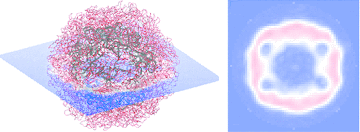Fluctuation X-ray scattering

In biology, materials science and the energy sciences, structural information provides important insights into the understanding of matter. The link between a structure and its properties can suggest new avenues for designed improvements of synthetic materials or provide new fundamental insights in biology and medicine at the molecular level.
During standard X-ray solution scattering experiments, molecules tumble around during X-ray exposures, resulting in an angularly isotropic diffraction pattern because of the full orientational averaging of the molecules that scatter X-rays. When X-ray snapshots are collected at timescales shorter than a few nano-seconds, such that molecules are virtually frozen in space and time during the scattering experiment, X-ray diffraction patterns are obtained that are no longer angularly isotropic. These measurements, called fluctuation X-ray scattering, are typically performed on an X-ray free electron laser or on a ultra-bright synchrotron and can provide fundamental insights into the structure of biological molecules, engineered nanoparticles or energy-related mesoscopic materials not attainable via standard scattering methods.
A group of scientists from the Lawrence Berkeley National Laboratory recently presented an intuitive view of the nature of fluctuation X-ray scattering data and their properties. The scientists have shown that fluctuation scattering is a natural extension of traditional small-angle X-ray scattering and that a number of fundamental operational properties translate from small- and wide-angle X-ray scattering into fluctuation scattering. The authors also show that even with a fairly limited fluctuation scattering dataset, the amount of recoverable structural detail is greatly increased as compared to what can be obtained from standard SAXS/WAXS experiments. Given that the high-quality structural models can be obtained from fluctuation scattering data and the ever-increasing availability of X-ray sources at which these experiments can be performed, the researchers expect that fluctuation scattering experiments will become routine in the future.
"Although fluctuation scattering experiments are not standard or routine at the moment, this work enables us to assess the quality of experimental data and allows us validate our experimental protocols and data reduction routines" Peter Zwart says.
More information: Malmerberg et al., (2015), IUCrJ, 2, DOI: 10.1107/S2052252515002535 . dx.doi.org/10.1107/S2052252515002535
Provided by International Union of Crystallography



















